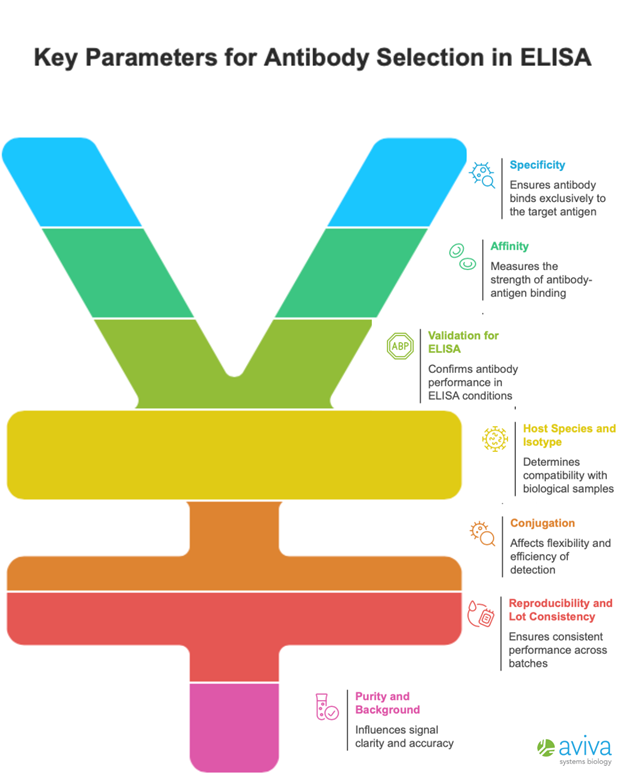
7 Considerations for Building a Reliable ELISA Assay

Researchers often spend months isolating a biomolecule for their study. When it comes time to test, the first application they turn to is often ELISA, the most trusted method for detecting and quantifying proteins, peptides, hormones, and antibodies with high accuracy. However, the difference between clean, reproducible data and frustrating background noise can come down to a single factor: the antibody.
7 Parameters for Selecting an Antibody to Power Your ELISA
We suggest researchers consider the following 7 parameters when selecting the antibody for their ELISA assay.
1. Specificity
In ELISA, specificity measures the antibody’s ability to recognize and bind exclusively to the intended antigenic epitope without interacting with structurally similar molecules. High specificity ensures that the measured signal corresponds only to the analyte of interest, enabling accurate quantification. When an antibody exhibits cross-reactivity, it binds to off-target molecules that share partial epitope homology or structural motifs with the target. This cross reactivity often -
- Elevates background noise, which reduces the signal-to-noise ratio (SNR).
- False-positive results, where non-target analytes contribute to the detected signal.
- Reduced assay accuracy and reproducibility, due to variations in cross-reactive proteins across samples
2. Affinity
For a successful signal on ELISA the interaction between antibody and its antigenic epitope should be strong which is often described as affinity. High-affinity antibodies maintain stable binding, which is particularly critical when detecting low-abundance analytes. In ELISA, strong binding improves sensitivity and reduces the risk of dissociation during washing steps. Weak or unstable binding may lead to signal loss. This increases the detection limit affecting sensitivity leading to inconsistent signals compromising the quantitative accuracy to your experiment.
3. Validation for ELISA
Antibodies are often validated for multiple applications, but performance in one assay (e.g., Western blot, immunocytochemistry, or immunoprecipitation) does not guarantee success in another. ELISA typically requires the antibody to recognize the antigen in its native, correctly folded conformation, preserving tertiary and quaternary structures. This structural difference means epitopes accessible in WB may be hidden or conformationally altered in ELISA.
Without ELISA-specific validation, antibody binding sites may be sterically hindered or conformationally masked, resulting in weak or absent signals. This can lead to false negatives, reducing assay sensitivity and misrepresenting the presence of the target analyte. Additionally, off-target interactions may increase as antibodies partially recognize similar conformational motifs on unrelated proteins, exacerbating cross-reactivity. Assay reproducibility can also suffer, particularly when comparing samples with variable post-translational modifications, such as glycosylation or phosphorylation, which can further alter epitope accessibility.
4. Host Species and Isotype
The antibody’s host species (e.g., mouse, rabbit, goat) and isotype (e.g., IgG1, IgG2a, IgM) dictate which detection systems can be used. These factors are critical for designing compatible secondary antibody strategies. If both capture and detection antibodies are raised in the same species, secondary antibodies may bind nonspecifically to both, producing false positives. Some isotypes (e.g., IgM vs. IgG subclasses) have different binding properties and may interact with Fc receptors or endogenous immunoglobulins in complex biological samples, leading to cross-reactivity.
Thus, designing multi-analyte ELISAs requires careful selection of antibodies from different host species or isotypes to ensure clean separation of signals.
5. Conjugation
Antibodies may be supplied conjugated to detection molecules such as HRP, alkaline phosphatase, or biotin. While conjugated antibodies streamline workflows, they also restrict flexibility in assay design. The conjugate must align with the chosen substrate (e.g., HRP with TMB, AP with pNPP). Poorly controlled conjugation can block the antigen-binding site, reducing affinity and assay sensitivity. Over-conjugation can increase background, while under-conjugation reduces detection strength.
6. Reproducibility and Lot Consistency
Lot-to-lot consistency is one of the most overlooked yet critical factors in ELISA reliability, as even small shifts in antibody production can significantly alter assay performance. Variability arises from differences in immunogen preparation (e.g., peptide purity or protein folding), purification methods (Protein A/G vs. antigen-affinity columns), and buffer composition or stabilizers (BSA, gelatin, azide), all of which can impact binding characteristics, background noise, and downstream conjugation. Polyclonal antibodies are especially vulnerable since each batch derives from different animal responses, creating shifts in epitope recognition, whereas recombinant monoclonals offer sequence-defined reproducibility. These inconsistencies can lead to changes in signal intensity, sensitivity, and reproducibility across experiments, undermining biomarker studies and delaying regulated assay development.
7. Purity and Background
Antibody purity is a critical determinant of ELISA performance, directly affecting background signal, sensitivity, and assay reproducibility. Low-purity preparations often contain residual serum proteins, host cell proteins, or stabilizers such as BSA, gelatin, or sodium azide, which can adsorb nonspecifically to ELISA plates and increase background noise. These impurities not only mask true antigen–antibody interactions, reducing signal-to-noise ratio, but can also interfere with downstream modifications like enzyme or biotin conjugation, where carrier proteins compete for reactive groups and compromise labeling efficiency.
Each parameter, from specificity and affinity to reproducibility and purity, directly impacts whether your results are robust enough to guide discovery, regulatory submission, or therapeutic development.
Aviva not only offers a vast catalog of validated, ready-to-use ELISA antibodies, but also partners with researchers to develop custom antibodies that are engineered around these exact parameters. Whether you need improved specificity to reduce background, recombinant antibodies for lot-to-lot consistency, or custom conjugation for your assay design, Aviva provides solutions that align with your research needs.

